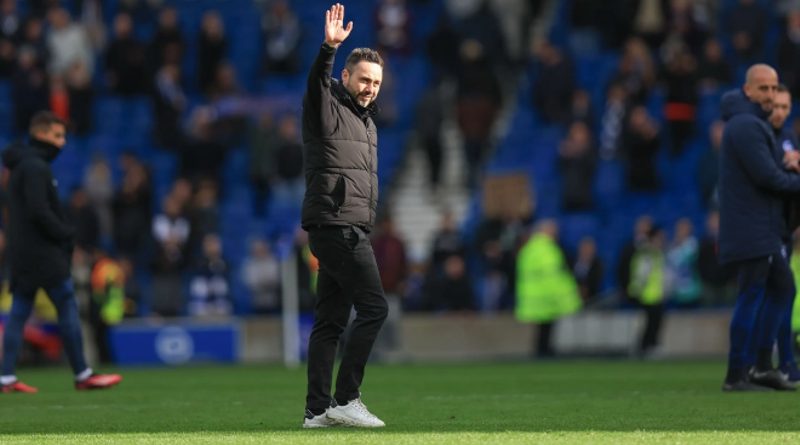Top four metrics can give Brighton even greater hope for 2023-24
And so the end of the most successful season in Brighton & Hove Albion history. Sixth place and qualification for the Europa League. But what else can we take from 2022-23 when considering the Seagulls’ underlying performance statistics?
Whilst Graham Potter remains under consideration for job of Crystal Palace manager, let us first consider an alternative reality where he is appointed as the all-powerful chief of the Premier League, able to make any changes he wants.
As the Tsar of Expected Goals, he decrees the four Champions League places should instead go to the top four based on expected points.
And as as a result, Brighton immediately take the place of Manchester United and join Manchester City, Arsenal and Newcastle United in the Champions League.
This alternative reality is enough to persuade Alexis Mac Allister to turn down Liverpool and Moises Caicedo to reject whoever comes in for him over the remainder of the summer transfer window.
Who knows where this in turn leads? Maybe the entertaining opinion piece posted on Football365 which maps out the next three years for the Albion under Roberto De Zerbi ending in the treble comes to pass?
Coming back to reality and whilst there as not even bigger history made via Champions League qualification, analysing Brighton’s performance metrics give many more reasons to look forward positively.
We start with the 2022-23 expected points table, courtesy of Understat.com. It uses expected goals for and against to recalculate the final standings.
As the Understat.com table shows, Brighton are no longer the Kings of Expected Goals but have moved to being one of the princes by reducing the discrepancy between how many times they put the ball in the net compared to how many times they should.
The Albion’s expected goals performance in 2022-23 would have seen six more goals scored, three less conceded and a total of nine extra points – finishing in the expected table in fourth place just behind Arsenal and Newcastle.
Interestingly, set pieces are the individual marker which contributed most to Brighton delivering results slightly below performance. Six goals were scored from corners and free kicks against an expected 14.
The expected points table indicates that Leicester were perhaps unlucky to be relegated, and that the actual Premier League standings give a falsely positive view of the performances of Fulham, Wolves and Bournemouth.
Moving beyond the headline expected points performance, there are further metrics which highlight how the Albion’s performance and playing style under Roberto De Zerbi is consistently top four.
Sky Sports covered this in another enjoyable read before the FA Cup semi final with Manchester United, calling De Zerbi’s Brighton “the monster coming over the hill in the top four race“.
Pep Guardiola said before Manchester City visited the Amex towards the end of the season: “The best team in the world in making the build-up, the best team, is Brighton.”
“There’s no team better that make the process to bring the keeper, the ball, to the last quarter. There’s no team better in modern football right now.”
The tables below highlight Brighton’s position on a range of key performance metrics (from Premier League and Opta Stats) supporting that statement.
In their 1-1 draw against City, Brighton managed 20 shots on goal. That total was the third highest ever in a top flight league match against a team managed by Guardiola. Only Wolves (21 v Man City in December 2019) and Atletico Madrid (22 v Barcelona in March 2009) have managed more.
This was no fluke or one-off; Brighton had both the most shots and most shots on target of anyone in the Premier League in the 2022-23 season.
And despite this attacking emphasis, the Albion remain rock solid at the back with the fourth best record for expected goals conceded.
Brighton’s stats for overall possession and sequences of at least 10 passes are equally impressive. The Albion also played the fewest long balls in 2022-23, demonstrating the success with which they are able to pass their way out of trouble at the back.
The Albion’s ability to press is demonstrated by their creating the most chances from a high press and showing fourth on the PPDA standings.
PPDA measures the intensity of a high press. It it a count of the number of passes an opposition defence makes before stopped by a defensive action.
Only one performance metric stands out with clear room for significant improvement – the aforementioned set piece metric.
As highlighted by these numbers put together by The Athletic, Brighton have the worst set piece conversion and concession rates.


There are two issues to consider with this. Firstly, unlike all the other statistics, there is essentially no correalation between set piece performance and league position.
Secondly, in a number of games, the Albion’s opponents have clearly had a significant height advantage. The flip side of Brighton having a squad of smaller, technically gifted players is that many of the metrics mentioned in this article are boosted by such individuals.
It is surely better to be top four in so many different areas which play a crucial role in the modern game, even if that means sacrificing height and physicality and the benefits those attributes bring from set pieces.
But even considering that as a reason for this underperformance, those set piece numbers indicate one area where improvement is very possible. An improvement which could even lead the Albion into the Champions League in the not-too-distant future.
Peter Finn




